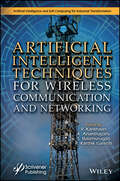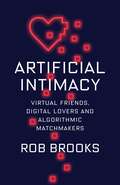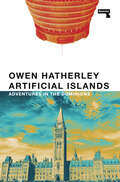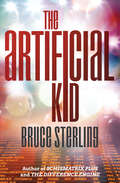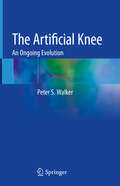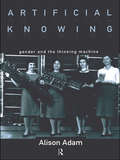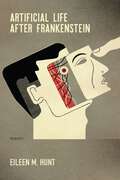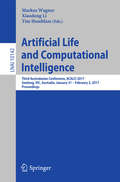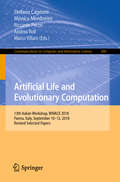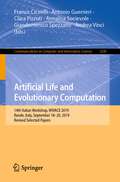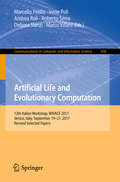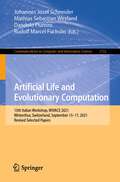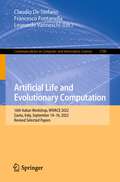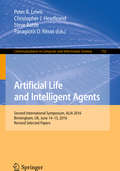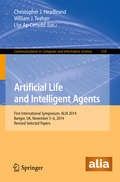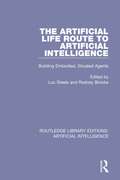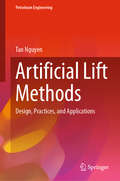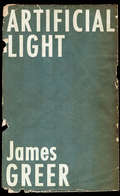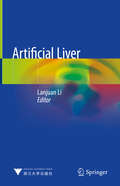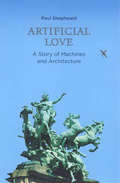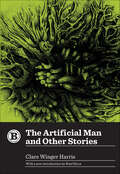- Table View
- List View
Artificial Intelligent Techniques for Wireless Communication and Networking
by R. Kanthavel K. Ananthajothi S. Balamurugan R. Karthik GaneshARTIFICIAL INTELLIGENT TECHNIQUES FOR WIRELESS COMMUNICATION AND NETWORKING The 20 chapters address AI principles and techniques used in wireless communication and networking and outline their benefit, function, and future role in the field. Wireless communication and networking based on AI concepts and techniques are explored in this book, specifically focusing on the current research in the field by highlighting empirical results along with theoretical concepts. The possibility of applying AI mechanisms towards security aspects in the communication domain is elaborated; also explored is the application side of integrated technologies that enhance AI-based innovations, insights, intelligent predictions, cost optimization, inventory management, identification processes, classification mechanisms, cooperative spectrum sensing techniques, ad-hoc network architecture, and protocol and simulation-based environments. Audience Researchers, industry IT engineers, and graduate students working on and implementing AI-based wireless sensor networks, 5G, IoT, deep learning, reinforcement learning, and robotics in WSN, and related technologies.
Artificial Intimacy: Virtual Friends, Digital Lovers, and Algorithmic Matchmakers
by Rob BrooksWhat happens when the human brain, which evolved over eons, collides with twenty-first-century technology? Machines can now push psychological buttons, stimulating and sometimes exploiting the ways people make friends, gossip with neighbors, and grow intimate with lovers. Sex robots present the humanoid face of this technological revolution—yet although it is easy to gawk at their uncanniness, more familiar technologies based in artificial intelligence and virtual reality are insinuating themselves into human interactions. Digital lovers, virtual friends, and algorithmic matchmakers help us manage our feelings in a world of cognitive overload. Will these machines, fueled by masses of user data and powered by algorithms that learn all the time, transform the quality of human life?Artificial Intimacy offers an innovative perspective on the possibilities of the present and near future. The evolutionary biologist Rob Brooks explores the latest research on intimacy and desire to consider the interaction of new technologies and fundamental human behaviors. He details how existing artificial intelligences can already learn and exploit human social needs—and are getting better at what they do. Brooks combines an understanding of core human traits from evolutionary biology with analysis of how cultural, economic, and technological contexts shape the ways people express them. Beyond the technology, he asks what the implications of artificial intimacy will be for how we understand ourselves.
Artificial Islands: Adventures in the Dominions
by Owen HatherleyShould Britain form a new union with its old 'Dominions' in Canada, Australia and New Zealand? Are they really our closest allies and relations? And is there any reason why they should want to unite again with us?Great Britain has just left one Union, after years of bitter argument and divisive posturing. But what if the island's future lies in another Union altogether, with some of its former colonial &“kith and kin&” across the seas? Why be in a Union with your immediate neighbours, when you could instead be in a trans-oceanic super-state with our old friends in Canada, Australia and New Zealand? Welcome to the strange world of the 'CANZUK Union', the name for a quixotic but apparently serious plan to reunify the white-majority 'Dominions' of the British Empire under the flag of low taxes, strong borders and climate change denialism.Artificial Islands tests the idea that Britain's natural allies and closest relations are in these three countries in North America and the Antipodes, through a good look at the histories, townscapes and spaces of several cities across the settler zones of the British Empire. These are some of the most purely artificial and modern landscapes in the world, British-designed cities that were built with extreme rapidity in forcibly seized territories on the other side of the world from Britain. Were these places really no more than just a reproduction of British Values planted in unlikely corners of the globe? How are people in Auckland, Melbourne, Montreal, Ottawa and Wellington re-imagining their own history, or their countries' role in the British Empire and their complicity in its crimes? And do they have any interest in a union with us?
The Artificial Kid (Cortext: Science Fiction That Changed The World Ser.)
by Bruce SterlingIn a future world of rampant inequality, a martial-arts video star finds himself in a real fight for survival, in this novel by the author of Schismatrix. Founded centuries ago by the enigmatic genius Moses Moses, the planet Reverie can either be heaven or hell, depending on whether you live on or above it. The superrich orbit the world in luxury abodes, keeping their sometimes-lethal ennui at bay by watching homemade sex and violence videos created by the peons dwelling on the coral continents miles beneath them. The most popular entertainer of all is the Artificial Kid, an unbeatable combat artist whose bloody, self-produced martial arts videos have made him beloved both above and below. But the Kid is about to stumble onto something no one was ever meant to discover—a mind-boggling conspiracy of science and antiquity that forces him to run for his life into the strange and dangerous wilderness known as the Mass. And when Moses Moses returns to Reverie after seven hundred years of cryogenic sleep, things are about to get much worse. Written long before the era of YouTube, Ultimate Fighting, and reality TV, Bruce Sterling&’s prescient, thoughtful, and wildly satiric novel previews the nascent cyberpunk sensibilities of the acclaimed author&’s later works.
The Artificial Knee: An Ongoing Evolution
by Peter S. WalkerSpanning both the history and future of knee replacement, this unique book recounts how artificial knees have reached the stage they are today, and whether their performance can be further improved. The author, who has been designing artificial knees for 50 years, starts the story in the late 1960’s with the early pioneers; during the 1970’s, the principles for successful artificial knees were established. While many different types were designed, a small number have become by far the most widely utilized. Yet other types of designs, so far little used, along with new materials and the application of computer-assisted surgery, could result in significant advancements in the treatment of knee arthritis.Each chapter provides a detailed description of the origins of the ideas and principles and their rationale, followed by the latest information and evidence. The book begins with an overview of the history and background of the artificial knee, in terms of design and implementation and the thought leaders involved. Fixation, biomechanics, and the types of designs are discussed in detail, both what has worked and what has not, and why. Instrumentation, testing and tribology, and functional evaluation methods are also covered. The book concludes with a look toward the future possibilities for the field of artificial knees. An illustrated glossary of terms, is included for quick reference.The Artificial Knee: An Ongoing Evolution will appeal to orthopedic surgeons and researchers, medical academics and orthopedic companies, and to those with a general interest in artificial knees.
Artificial Knowing: Gender and the Thinking Machine
by Alison AdamArtificial Knowing challenges the masculine slant in the Artificial Intelligence (AI) view of the world. Alison Adam admirably fills the large gap in science and technology studies by showing us that gender bias is inscribed in AI-based computer systems. Her treatment of feminist epistemology, focusing on the ideas of the knowing subject, the nature of knowledge, rationality and language, are bound to make a significant and powerful contribution to AI studies. Drawing from theories by Donna Haraway and Sherry Turkle, and using tools of feminist epistemology, Adam provides a sustained critique of AI which interestingly re-enforces many of the traditional criticisms of the AI project. Artificial Knowing is an esential read for those interested in gender studies, science and technology studies, and philosophical debates in AI.
Artificial Life: How to Create a Life Computationally (Intelligent Systems Reference Library #262)
by Seiki AkamaThis book provides some resources of Artificial Life. Artificial Life (ALife or A-Life) is the research area which simulates a life computationally. It involves several approaches to living systems in artificial manners. It was recognized as a scientific field in the 1980's. Artificial Life is related to many scientific fields including biology and computer science, and its history is old. In fact, the earlier works have been done by people like Turing and von Neumann. Fields like that neural networks, evolutionary computation, and cellular automaton constitute the foundations for Artificial Life. The so-called wet ware is an approach in more biology-oriented, which is known that there are some Artificial Life Systems at present. It is expected to see further progresses of this exciting field. The materials include: history, philosophy, related areas, recent developments, etc. Starting from the overview, the authors give an exposition of basic subjects like cellular automaton, neural networks, evolutionary computation, and wet ware. The authors also introduce some examples of Artificial Life Systems like Boids, Tierra, and Open Warm. The book is intended for those, like experts and students, who wish to get involved in the field as a monograph or a textbook for the subject. It is also useful for beginners. But, the authors assume that the reader has mastered the material ordinarily covered in AI and mathematics.
Artificial Life: The Quest for a New Creation
by Steven LevyBiologists, mathematicians, and computer scientists learn what computers can do when given the opportunity to "think".
Artificial Life After Frankenstein
by Eileen M. HuntArtificial Life After Frankenstein brings the insights born of Mary Shelley's legacy to bear upon the ethics and politics of making artificial life and intelligence in the twenty-first century.What are the obligations of humanity to the artificial creatures we make? And what are the corresponding rights of those creatures, whether they are learning machines or genetically modified organisms? In seeking ways to respond to these questions, so vital for our age of genetic engineering and artificial intelligence, we would do well to turn to the capacious mind and imaginative genius of Mary Wollstonecraft Shelley (1797-1851). Shelley's novels Frankenstein; or, The Modern Prometheus (1818) and The Last Man (1826) precipitated a modern political strain of science fiction concerned with the ethical dilemmas that arise when we make artificial life—and make life artificial—through science, technology, and other forms of cultural change.In Artificial Life After Frankenstein, Eileen Hunt Botting puts Shelley and several classics of modern political science fiction into dialogue with contemporary political science and philosophy, in order to challenge some of the apocalyptic fears at the fore of twenty-first-century political thought on AI and genetic engineering. Focusing on the prevailing myths that artificial forms of life will end the world, destroy nature, and extinguish love, Botting shows how Shelley modeled ways to break down and transform the meanings of apocalypse, nature, and love in the face of widespread and deep-seated fear about the power of technology and artifice to undermine the possibility of humanity, community, and life itself.Through their explorations of these themes, Mary Shelley and authors of modern political science fiction from H. G. Wells to Nnedi Okorafor have paved the way for a techno-political philosophy of living with the artifice of humanity in all of its complexity. In Artificial Life After Frankenstein, Botting brings the insights born of Shelley's legacy to bear upon the ethics and politics of making artificial life and intelligence in the twenty-first century.
Artificial Life and Computational Intelligence: Third Australasian Conference, ACALCI 2017, Geelong, VIC, Australia, January 31 – February 2, 2017, Proceedings (Lecture Notes in Computer Science #10142)
by Xiaodong Li Markus Wagner Tim HendtlassThis book constitutes the refereed proceedings of the Third Australasian Conference on Artificial Life and Computational Intelligence, ACALCI 2017, held in Geelong, VIC, Australia, in January/February 2017. The 32 papers presented in this volume were carefully reviewed and selected from 47 submissions. They were organized in topical sections named: artificial life and computational intelligence and optimization algorithms and applications.
Artificial Life and Computational Intelligence: Second Australasian Conference, ACALCI 2016, Canberra, ACT, Australia, February 2-5, 2016, Proceedings (Lecture Notes in Computer Science #9592)
by Tapabrata Ray Ruhul Sarker Xiaodong LiThis bookconstitutes the proceedings of the Second Australasian Conference on ArtificialLife and Computational Intelligence, ACALCI 2016, held in Canberra, ACT,Australia, in February 2016. The 30 fullpapers presented in this volume were carefully reviewed and selected from 41submissions. They are organized in topical sections named: mathematicalmodeling and theory; learning and optimization; planning and scheduling;feature selection; and applications and games.
Artificial Life and Evolutionary Computation: 13th Italian Workshop, WIVACE 2018, Parma, Italy, September 10–12, 2018, Revised Selected Papers (Communications in Computer and Information Science #900)
by Stefano Cagnoni Monica Mordonini Riccardo Pecori Andrea Roli Marco VillaniThis book constitutes the revised selected papers of the 13th Italian Workshop on Artificial Life and Evolutionary Computation, WIVACE 2018, held in Parma, Italy, in September 2018. The 12 full papers presented were thoroughly reviewed and selected from 30 submissions. They cover the following topics: Boolean networks and complex systems; economic, societal and technological applications; chemical, biological and medical applications. The chapter “Unveiling Latent Relations in the Photonics Techno-Economic Complex System” is open access under a CC BY 4.0 license at link.springer.com.
Artificial Life and Evolutionary Computation: 14th Italian Workshop, WIVACE 2019, Rende, Italy, September 18–20, 2019, Revised Selected Papers (Communications in Computer and Information Science #1200)
by Franco Cicirelli Antonio Guerrieri Clara Pizzuti Annalisa Socievole Giandomenico Spezzano Andrea VinciThis book constitutes the revised selected papers of the 14th Italian Workshop on Artificial Life and Evolutionary Computation, WIVACE 2019, held in Rende, Italy, in September 2019.The 13 full papers and 4 short paper presented were thoroughly reviewed and selected from 31 submissions. They are focused on the topics of information systems, design and analysis of algorithms, artificial intelligence, machine learning, cognitive science, modeling and simulation, collaborative and social computing, parallel computing, distributed computing. The chapter “Nestedness Temperature in the Agent-Artifact Space: Emergence of Hierarchical Order in the 2000-2014 Photonics Techno-Economic Complex System” is available open access under a CC BY 4.0 license.
Artificial Life and Evolutionary Computation: 12th Italian Workshop, WIVACE 2017, Venice, Italy, September 19-21, 2017, Revised Selected Papers (Communications In Computer And Information Science #830)
by Irene Poli Marcello Pelillo Marco Villani Roberto Serra Andrea Roli Debora SlanziThis book constitutes the revised selected papers of the 12th Italian Workshop on Advances in Artificial Life, Evolutionary Computation, WIVACE 2017, held in Venice, Italy, in September 2017.The 23 full papers presented were thoroughly reviewed and selected from 33 submissions. They cover the following topics: physical-chemical phenomena; biological systems; economy and society; complexity; optimization.
Artificial Life and Evolutionary Computation: 15th Italian Workshop, WIVACE 2021, Winterthur, Switzerland, September 15–17, 2021, Revised Selected Papers (Communications in Computer and Information Science #1722)
by Johannes Josef Schneider Mathias Sebastian Weyland Dandolo Flumini Rudolf Marcel FüchslinThis book constitutes the proceedings of the 15th Italian Workshop on Artificial Life and Evolutionary Computation, WIVACE 2021, held in Winterthur, Switzerland, in September 2022. The 14 full papers and 10 short papers presented in this volume were carefully reviewed and selected from 25 submissions. The papers are organized in the following topical sections: Networks; Droplets, Fluids, and Synthetic Biology; Robot Systems; Computer Vision and Computational Creativity; Semantic Search; Artificial Medicine and Pharmacy; Trade and Finance; Ethics in Computational Modelling.
Artificial Life and Evolutionary Computation: 16th Italian Workshop, WIVACE 2022, Gaeta, Italy, September 14–16, 2022, Revised Selected Papers (Communications in Computer and Information Science #1780)
by Claudio De Stefano Francesco Fontanella Leonardo VanneschiThis book constitutes the refereed proceedings of the 16th Italian Workshop on Artificial Life and Evolutionary Computation, WIVACE 2022, held in Gaeta, Italy, during September 14–16, 2022. The 21 full papers and 3 short papers included in this book were carefully reviewed and selected from 45 submissions. They were organized in topical sections as follows: answer set programming; networks and complex systems, metaheuristics, robotics, and machine learning
Artificial Life and Evolutionary Computation: 17th Italian Workshop, WIVACE 2023, Venice, Italy, September 6–8, 2023, Revised Selected Papers (Communications in Computer and Information Science #1977)
by Marco Villani Stefano Cagnoni Roberto SerraThis book constitutes the refereed post proceedings of the 17th Italian Workshop on Artificial Life and Evolutionary Computation, WIVACE 2023, held in Venice, Italy, during September 6–8, 2023.The 30 full papers included in this book were carefully reviewed and selected from 55 submissions. They were organized in topical sections as follows: Algorithms for complex systems, Biologically inspired models, Complex chemical systems, Adaptation and swarms, Learning, Medicine and Social systems.
Artificial Life and Intelligent Agents: First International Symposium, ALIA 2014, Bangor, UK, November 5-6, 2014. Revised Selected Papers (Communications In Computer And Information Science #732)
by Christopher J. Headleand Peter R. Lewis Panagiotis D. Ritsos Steve BattleThis book constitutes the refereed proceedings of the Second International Symposium on Artificial Life and Intelligent Agents, ALIA 2016, held in Birmingham, UK, in June 2016. The 8 revised full papers and three revised short papers presented together with two demo papers were carefully reviewed and selected from 25 submissions. The papers are organized in topical sections on modelling; robotics; bio-inspired problem solving; human-like systems; applications and games.
Artificial Life and Intelligent Agents: First International Symposium, ALIA 2014, Bangor, UK, November 5-6, 2014. Revised Selected Papers (Communications in Computer and Information Science #519)
by Christopher J. Headleand William J. Teahan Llyr Ap CenyddThis book constitutes the refereed proceedings of the First International Symposium on Artificial Life and Intelligent Agents, ALIA 2014, held in Bangor, UK, in November 2014. The 10 revised full papers were carefully reviewed and selected from 20 submissions. The papers are organized in topical sections on learning and evolution; human interaction; robotic simulation.
The Artificial Life Route to Artificial Intelligence: Building Embodied, Situated Agents (Routledge Library Editions: Artificial Intelligence #9)
by Luc Steels Rodney BrooksOriginally published in 1995, this volume is the direct result of a conference in which a number of leading researchers from the fields of artificial intelligence and biology gathered to examine whether there was any ground to assume that a new AI paradigm was forming itself and what the essential ingredients of this new paradigm were. A great deal of scepsis is justified when researchers, particularly in the cognitive sciences, talk about a new paradigm. Shifts in paradigm mean not only new ideas but also shifts in what constitutes good problems, what counts as a result, the experimental practice to validate results, and the technological tools needed to do research. Due to the complexity of the subject matter, paradigms abound in the cognitive sciences -- connectionism being the most prominent newcomer in the mid-1980s. This workshop group was brought together in order to clarify the common ground, see what had been achieved so far, and examine in which way the research could move further. This volume is a reflection of this important meeting. It contains contributions which were distributed before the workshop but then substantially broadened and revised to reflect the workshop discussions and more recent technical work. Written in polemic form, sometimes criticizing the work done thus far within the new paradigm, this collection includes research program descriptions, technical contributions, and position papers.
Artificial Lift Methods: Design, Practices, and Applications (Petroleum Engineering)
by Tan NguyenThis book details the major artificial lift methods that can be applied to hydrocarbon reservoirs with declining pressure. These include: the sucker rod pump, gas lift, electrical submersible pump, progressive cavity pump, and plunger lift. The design and applications, as well as troubleshooting, are discussed for each method, and examples, exercises and design projects are provided in order to support the concepts discussed in each chapter. The problems associated with oil recovery in horizontal wells are also explored, and the author proposes solutions to address the various extraction challenges that these wells present. The book represents a timely response to the difficulties associated with unconventional oil sources and declining wells, offering a valuable resource for students of petroleum engineering, as well as hydrocarbon recovery researchers and practicing engineers in the petroleum industry.
Artificial Light (Little House on the Bowery)
by James Greer&“Artificial Light beats the bejeezus out of the last dozen Thomas Pynchons, the last nineteen Don DeLillos, and the last forty-three Kurt Vonneguts.&”—Richard Meltzer &“In his ambitious and intriguing debut novel, indie rock expert Greer, author of Guided by Voices, employs one of literature's oldest gambits, the book-within-a-book structure, three times over. A young librarian calling herself Fiat Lux fills a set of notebooks with her passion for books and an enigmatic account of her interlude with Kurt C, a famous indie rock star who appears unheralded in Dayton, Ohio, and buys the long-abandoned Orville Wright mansion. A member of the rock group Whiskey Ships is trying to write about his musical odyssey but longs to return to his book about Orville Wright, whose long-lost diaries also feed the narrative stream. Greer picks the lock on the Kurt Cobain mythos and the rapid commercialization of indie rock…Strong writing and shrewd perceptions prevail, backed by wry humor, compelling stumblebum characters, a true-blue louche atmosphere, and arresting insights into the dream of art, be it literature or rock and roll.&”—Booklist
Artificial Liver
by Lanjuan LiThis book introduces the clinical application of artificial liver system (ALS) in hepatic failure. It has been widely used in clinics aiming to provide temporary support of liver function while maintaining extra-hepatic function in patients with liver failure. This work comprehensively summarizes the progress of livers and artificial liver, for example, the principle and implementation of Li-ALS, cell transplantation and the combined application of artificial liver and liver transplantation. It will be helpful for clinicians to implement artificial liver treatment to save the lives of patients with hepatic failure.
Artificial Love: A Story of Machines and Architecture (The\mit Press Ser.)
by Paul ShepheardA vision of architecture that includes sculpture, machines, and technology and encapsulates the history of the human species.According to Paul Shepheard, architecture is the rearranging of the world for human purposes. Sculpture, machines, and landscapes are all architecture-every bit as much as buildings are. In his writings, Shepheard examines old assumptions about architecture and replaces the critical theory of the academic with the active theory of the architect-citizen enamored of the world around him.Artificial Love weaves together three stories about architecture into one. The first, about machines as architecture, leads to speculations about technology and the human condition and to the assertion that machines are the sculptures of today. The second story is about the ways that architecture reflects the tribal and personal desires of those who make it. In the West, ideas of community, multiculturalism, and globalization compete furiously, leaving architecture to exist as it always has, as the past in the present. The third story features individual people experiencing their lives in the context of architecture. Here, Shepheard borrows the rhetorical device of Shakespeare's seven ages of man to propose that each person's life imitates the accumulating history of the human species. Shepheard's version of the history of humans is a technological one, in which machines become sculpture and sculpture becomes architecture. For Shepheard, our machines do not separate us from nature. Rather, our technology is our nature, and we cannot but be in harmony with nature. The change that we have wrought in the world, he says, is a wonderful and powerful thing.
The Artificial Man and Other Stories (Belt Revivals)
by Clare Winger Harris&“Much like Asimov . . . Harris&’ stories possess something of the eternal . . . They have retained their power to spark the imagination.&” —Tangent Online Science fiction has historically been seen as a man&’s game, but from the very beginning, women have made their indelible mark on the genre. One of science fiction&’s pioneers, Claire Winger Harris is credited as the first woman to publish under her own name in sci-fi magazines. In Harris&’s world, you&’ll find gigantic insects, Martians looking to steal Earth&’s water, and time travel to ancient Rome. Scholar Brad Ricca assembles ten of Harris's greatest short stories here, including &“The Fifth Dimension,&” &“The Fate of the Poseidonia,&” &“The Menace of Mars,&” and &“The Vibrometer.&” Their ideas are as fresh today as when Harris originally wrote them a century ago. A wonderful collection by a little-known master of science fiction, this book will hold interest for feminist readers and scholars of sci-fi alike.
